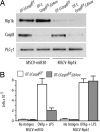Antigen-mediated T cell expansion regulated by parallel pathways of death
- PMID: 18981423
- PMCID: PMC2582294
- DOI: 10.1073/pnas.0808043105
Antigen-mediated T cell expansion regulated by parallel pathways of death
Abstract
T cells enigmatically require caspase-8, an inducer of apoptosis, for antigen-driven expansion and effective antiviral responses, and yet the pathways responsible for this effect have been elusive. A defect in caspase-8 expression does not affect progression through the cell cycle but causes an abnormally high rate of cell death that is distinct from apoptosis and does not involve a loss of NFkappaB activation. Instead, antigen or mitogen activated Casp8-deficient T cells exhibit an alternative type of cell death similar to programmed necrosis that depends on receptor interacting protein (Ripk1). The selective genetic ablation of caspase-8, NFkappaB, and Ripk1, reveals two forms of cell death that can regulate virus-specific T cell expansion.
Conflict of interest statement
The authors declare no conflict of interest.
Figures






References
-
- Doherty PC, Christensen JP. Accessing complexity: The dynamics of virus-specific T cell responses. Annu Rev Immunol. 2000;18:561–592. - PubMed
-
- De Boer RJ, Homann D, Perelson AS. Different dynamics of CD4+ and CD8+ T cell responses during and after acute lymphocytic choriomeningitis virus infection. J Immunol. 2003;171:3928–3935. - PubMed
-
- Ameisen JC. On the origin, evolution, and nature of programmed cell death: A timeline of four billion years. Cell Death Differ. 2002;9:367–393. - PubMed
-
- Green DR, Droin N, Pinkoski M. Activation-induced cell death in T cells. Immunol Rev. 2003;193:70–81. - PubMed
Publication types
MeSH terms
Substances
Grants and funding
LinkOut - more resources
Full Text Sources
Other Literature Sources
Molecular Biology Databases
Miscellaneous

